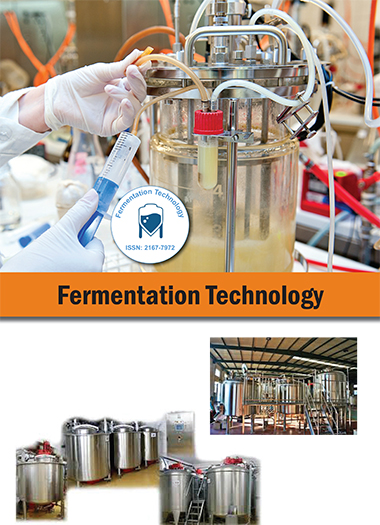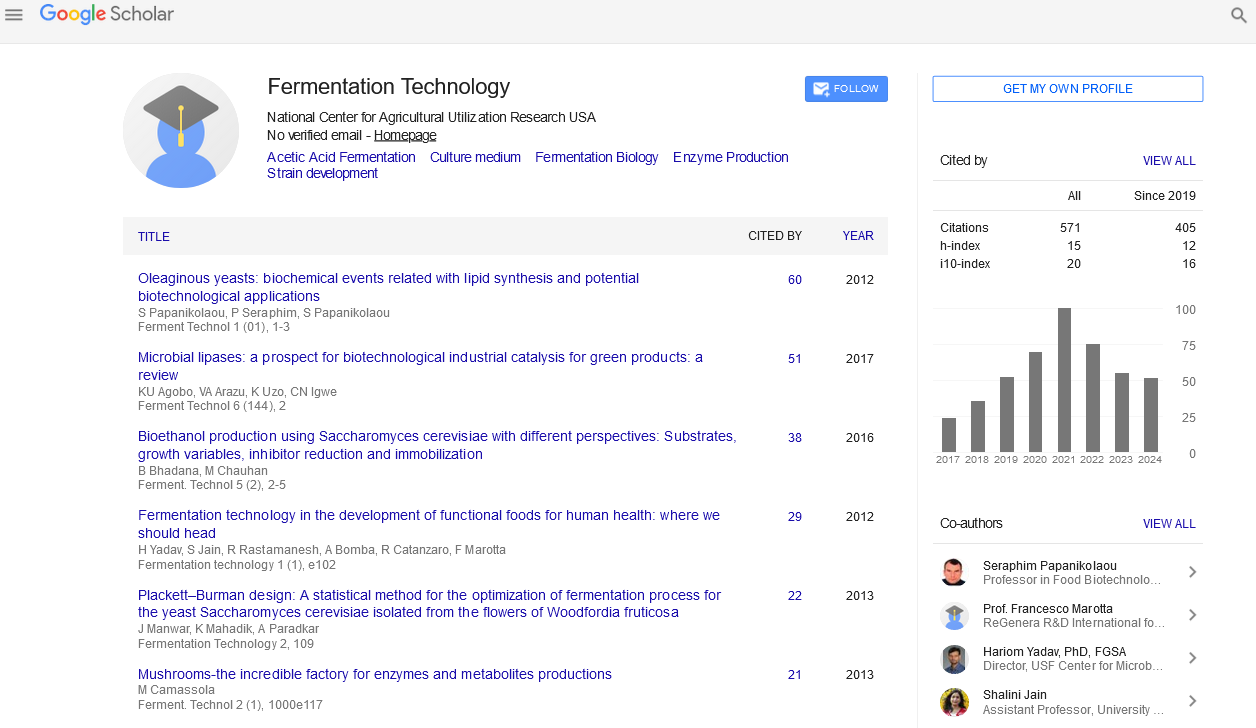Indexed In
- Open J Gate
- Genamics JournalSeek
- Access to Global Online Research in Agriculture (AGORA)
- RefSeek
- Hamdard University
- EBSCO A-Z
- OCLC- WorldCat
- Publons
Useful Links
Share This Page
Journal Flyer

Open Access Journals
- Agri and Aquaculture
- Biochemistry
- Bioinformatics & Systems Biology
- Business & Management
- Chemistry
- Clinical Sciences
- Engineering
- Food & Nutrition
- General Science
- Genetics & Molecular Biology
- Immunology & Microbiology
- Medical Sciences
- Neuroscience & Psychology
- Nursing & Health Care
- Pharmaceutical Sciences
Perspective - (2022) Volume 11, Issue 1
Production of Fermented Fish and Industrial Applications
Ruby Thomas*Received: 07-Nov-2022, Manuscript No. FMT-22-18924; Editor assigned: 09-Nov-2022, Pre QC No. FMT-22-18924 (PQ); Reviewed: 25-Nov-2022, QC No. FMT-22-18924; Revised: 01-Dec-2022, Manuscript No. FMT-22-18924 (R); Published: 08-Dec-2022, DOI: 10.4172/2167-7972.22.11.154
Description
Products made from fermented fish are widely popular in Southeast Asian nations, but they are also available elsewhere in the world. Fish fermentation is a long-used ancient technique that was used by our ancestors long ago. The perishable aspect of fish has historically been overcome through processing. Because they can offer a particular distinctive trait, particularly in terms of scent, flavor, and texture, fermented fish products typically have specialized consumers [1]. This results from the fermentation process in fish muscle tissue converting organic molecules into simpler chemicals through the activity of microbes or enzymes. Based on the source and substrate of the enzymatic used in fermenting, which comprises the three forms of technology processing mentioned, fish products are categorized. Fermented fish are rich in beneficial bacteria, making them a useful supplier of microorganisms that may have positive effects on nutrition and health. In 18 fermented fish items, Bacillus, Lactobacillus, Micrococcus, and Staphylococcus were the most prevalent bacterial taxa. Because they include significant amounts of carbohydrates, protein, fat, and lactic acid, fish products that have undergone fermentation are good for human health [2]. However, a key potential risk in traditionally fermented fish is the presence of biogenic amines, which are created by specific bacteria as a byproduct of their catabolic activity.
Food culture practices in many cultures throughout the world have used fermented fish as a food since very early times. In numerous societies throughout history, humans have created a variety of ways to preserve food supplies, such as fish, during times of scarcity after a seasonally ample supply. Due to the fish's perishable nature, it had to be preserved in a number of ways, such drying, salting, and fermenting. Globally, fish fermentation processing generally follows a similar path [3]. Small fish, like sardines, are either dried or utilized fresh for fermenting once the fish have indeed been captured. In salt liquors, these products spontaneously ferment with or without gutting or boning. Depending on the variety, fish paste is left at room temperature for one to several months. At this point, a number of bacterial and endogenous enzymes continue to solubilize fish proteins. In reality, several strains of bacteria can be isolated at this time, and throughout fermentation, the fungus and yeast loads usually decrease. Fish, in contrast to traditional carbohydrate fermentations, is a protein-rich substrate with little sugar. The most widely used pickled fish preparations in many Asian nations are fish sauce and fish pastes, which are regarded as essential seasonings in these culinary traditions. Fish sauce is created when microbial activity occurs in environments with high concentrations of salt and low oxygen levels, causing changes to the physical and chemical features [4]. Another type of pickled fish product keeps the fish in its solid state rather than turning it into a paste or a liquid. Fish which has undergone derivative alterations due to enzyme or microbial activity in the absence or presence of salt is often referred to as fermented fish. Globally, fish fermentation processing generally follows a similar path. Small fish, like sardines, are either dried or utilized fresh for fermenting once the fish have been captured. In salt liquors, these products spontaneously ferment with or without gutting or boning.
Depending on the variety, fish paste is preserved at room temperature for one to many months. At this point, a number of bacterial or natural enzymes continue to solubilize fish proteins. All foods that have undergone fermentation contain microorganisms. Due to the advantageous physicochemical features that these bacteria possess, Lactobacillus and other organisms in fermentation have been given the designation of "Generally Recognized as Safe," which has increased the commercial value of these goods. Different fermented seafood products from Asia have been reported to include a wide range of microorganisms [5]. Fish that has been fermented adds excellent organoleptic qualities and increases the product's mineral bioavailability. Compared to fresh fish, fermented fish has much lower levels of fatty acids Eicosapentaenoic acid and docosahexaenoic acid have been shown to be present in particularly high concentrations in fermented fish oil. DHA, which is present in fermented fish oil, can help to reduce the clinical symptoms of atopic dermatitis. Natural antioxidants and critical minerals are also present in fermented fish. According to a study, bioactive peptides made from fermented fish foods function as antioxidants. The composition of a great deal more conventional fermenting fish products that have been served for generations needs to be thoroughly investigated. These goods could contain multiple isolates from several species with ambiguous functions. Through the creation of innovative starter cultures and the addition of value through the supplementation of nutrients and probiotics, recent biotechnology tools have the ability to improve food fermentation. The health advantages of fermented foods will be highlighted, and new enterprises centered on them will be encouraged.
References
- Bel-Rhlid R, Berger RG, Blank I. Bio-mediated generation of food flavors–Towards sustainable flavor production inspired by nature. Trends Food Sci Technol.2018; 78:134-143.
- Xu Y, Zang J, Regenstein JM, Xia W. Technological roles of microorganisms in fish fermentation: a review. Crit. Rev. Food Sci. Nutr. 2021; 61(6):1000-1012.
[Crossref] [Google Scholar] [PubMed]
- Tamang JP, Cotter PD, Endo A, Han NS, Kort R, Liu SQ, et.al .Fermented foods in a global age: East meets west. Compr. Rev.Food Sci. Food Saf. 2020 ;(1):184-217.
[Crossref] [Google Scholar] [PubMed]
- Bover-Cid S, Izquierdo-Pulido M, Vidal-Carou MC. Changes in biogenic amine and polyamine contents in slightly fermented sausages manufactured with and without sugar. Meat Sci .2001; 57(2):215-221.
[Crossref] [Google Scholar] [PubMed]
- COBB III BF, ALANIZ I, THOMPSON JR CA. Biochemical and microbial studies on shrimp: volatile nitrogen and amino nitrogen analysis. J. Food Sci. 1973; 38(3):431-436.
Citation: Thomas R (2022) Production of Fermented Fish and Industrial Applications. Ferment Technol. 11:154.
Copyright: © 2022 Thomas R. This is an open-access article distributed under the terms of the Creative Commons Attribution License, which permits unrestricted use, distribution, and reproduction in any medium, provided the original author and source are credited.

